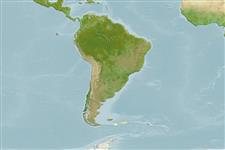Gastropoda |
Nudibranchia |
Tritoniidae
Environment: milieu / climate zone / depth range / distribution range
Ecology
Benthic; depth range 15 - 360 m (Ref. 87801). Subtropical; 53°S - 55°S, 71°E - 36°E (Ref. 83435)
Southeast Pacific, Southwest Atlantic and Antarctic Atlantic. Subtropical to polar.
Length at first maturity / Size / Weight / Age
Maturity: Lm ? range ? - ? cm Max length : 6.0 cm DL male/unsexed; (Ref. 83435)
It is found on rock walls at greater depths (Ref. 87801).
Life cycle and mating behavior
Maturity | Reproduction | Spawning | Eggs | Fecundity | Larvae
Members of the order Nudibranchia are simultaneous hermaphrodites. Mating behavior: Both individuals darts their penis toward each other to induce one to act as a male and the other as the female. The victorious one to penetrate the body wall is the dominant male. Life cycle: Eggs are deposited on a substratum where they develop and hatch into (planktonic) vestigial veliger larval stage and further grow as adults.
Rosenberg, G. 2009 Malacolog 4.1.1: A Database of Western Atlantic Marine Mollusca. [WWW database (version 4.1.1)] URL http://www.malacolog.org/. (Ref. 83435)
IUCN Red List Status
(Ref. 130435: Version 2025-1)
CITES status (Ref. 108899)
Not Evaluated
Not Evaluated
Threat to humans
Human uses
| FishSource |
Tools
More information
Trophic EcologyFood items (preys)
Diet composition
Food consumption
Predators
Population dynamicsGrowth
Max. ages / sizes
Length-weight rel.
Length-length rel.
Length-frequencies
Mass conversion
Abundance
Life cycleReproductionMaturityFecunditySpawningEggsEgg developmentLarvae PhysiologyOxygen consumption
Human RelatedStamps, coins, misc.
Internet sources
Estimates based on models
Preferred temperature
(Ref.
115969): 0.8 - 1.9, mean 1.8 (based on 4 cells).
Fishing Vulnerability
Low vulnerability (10 of 100).
Price category
Unknown.
